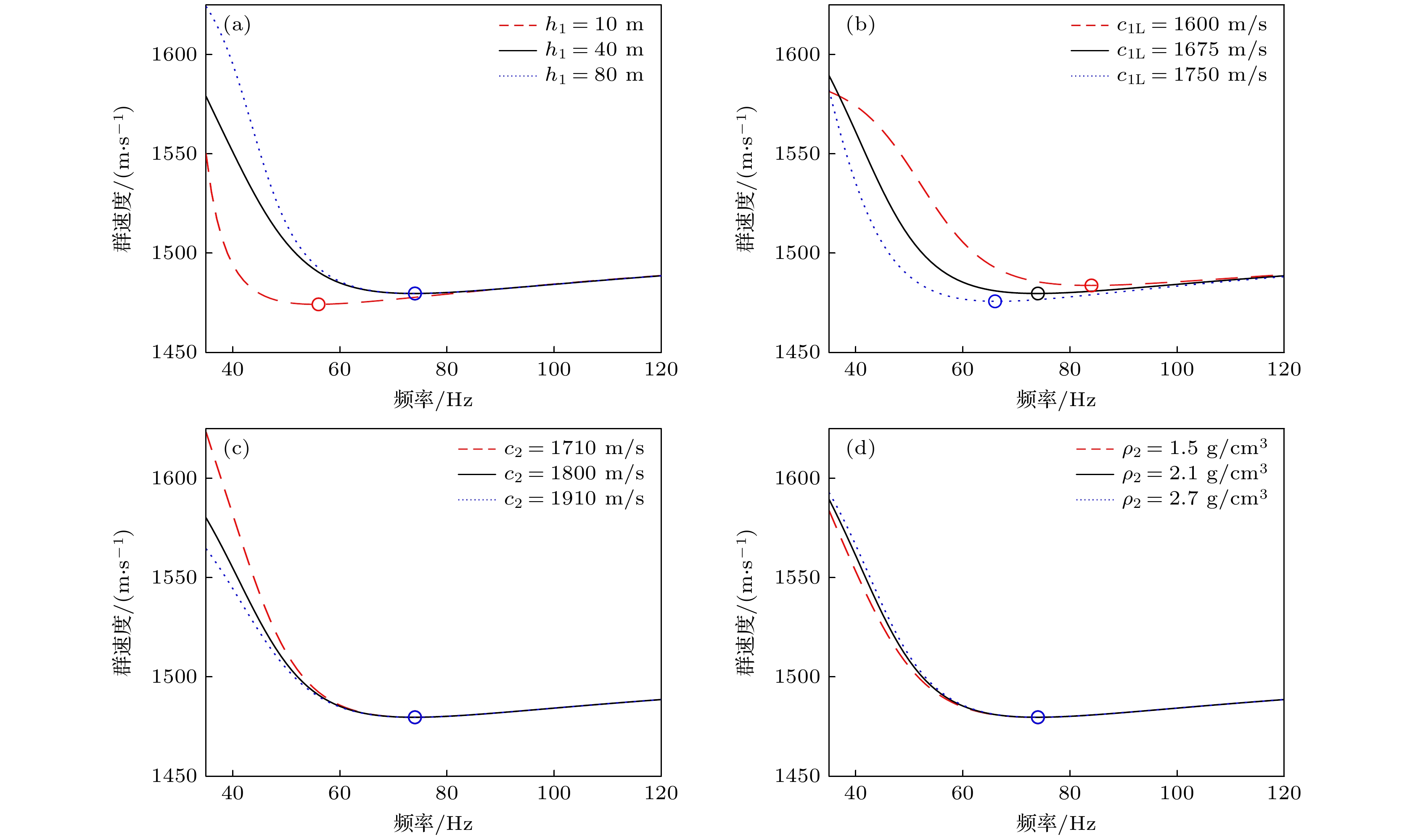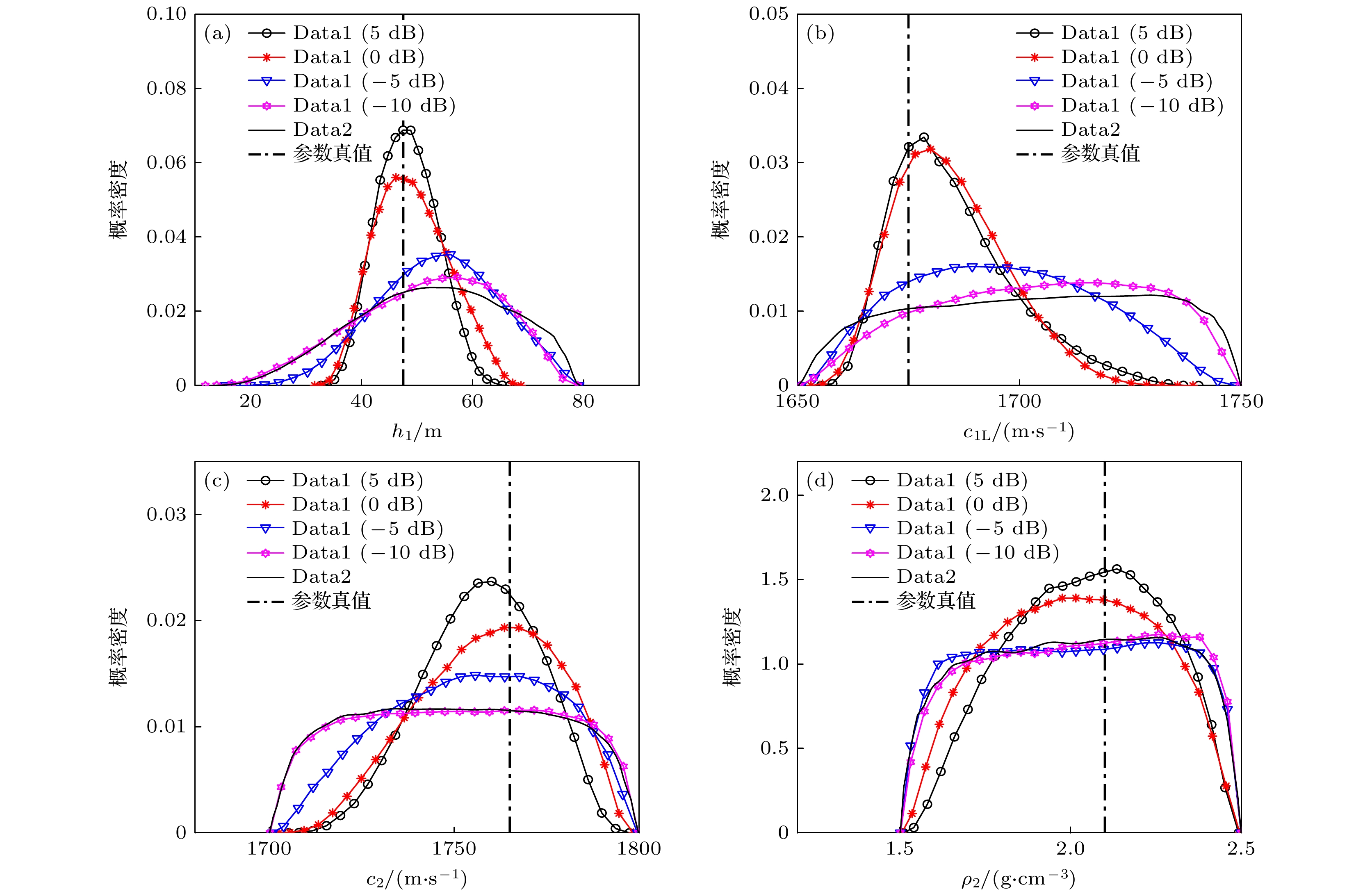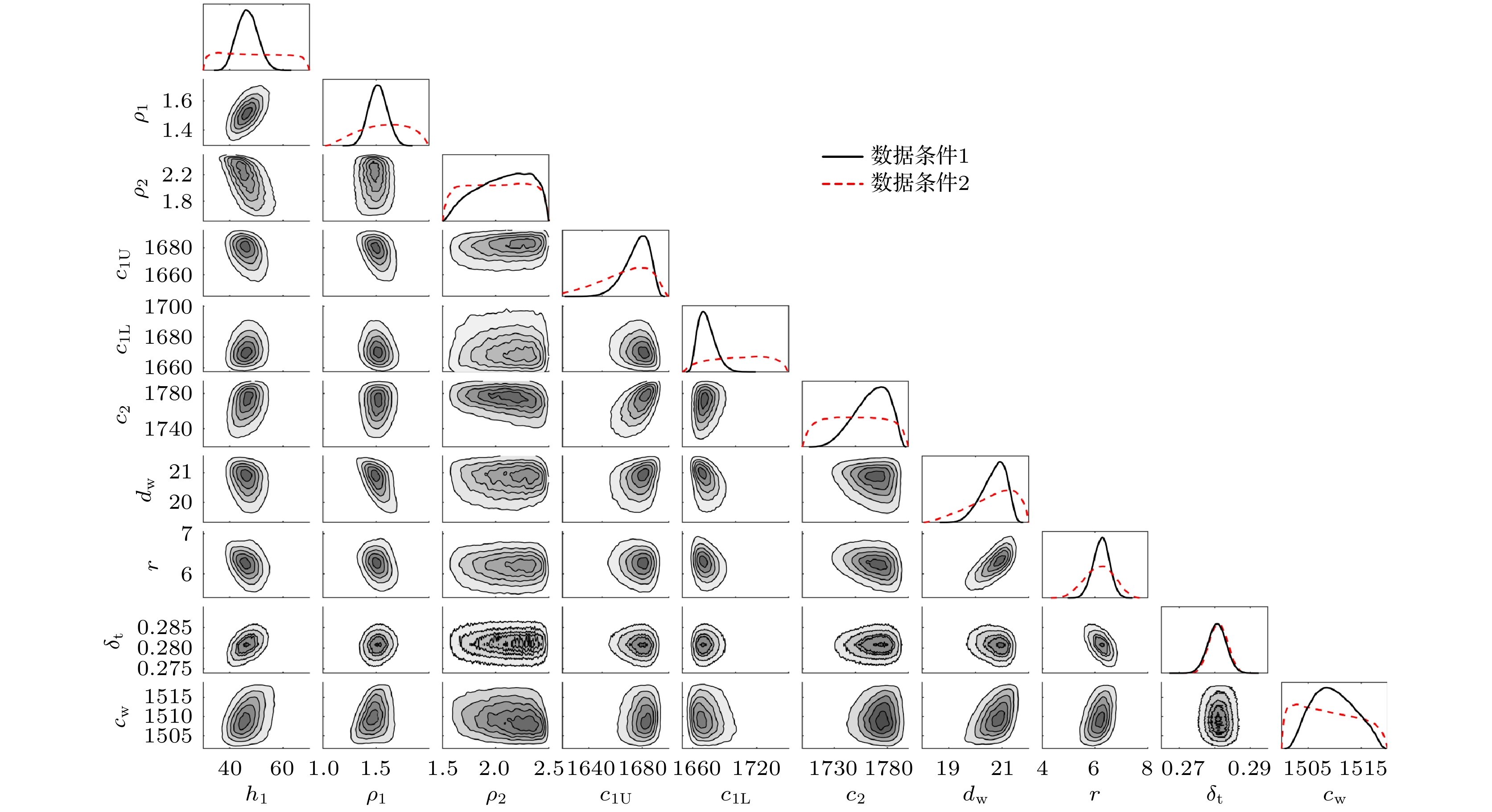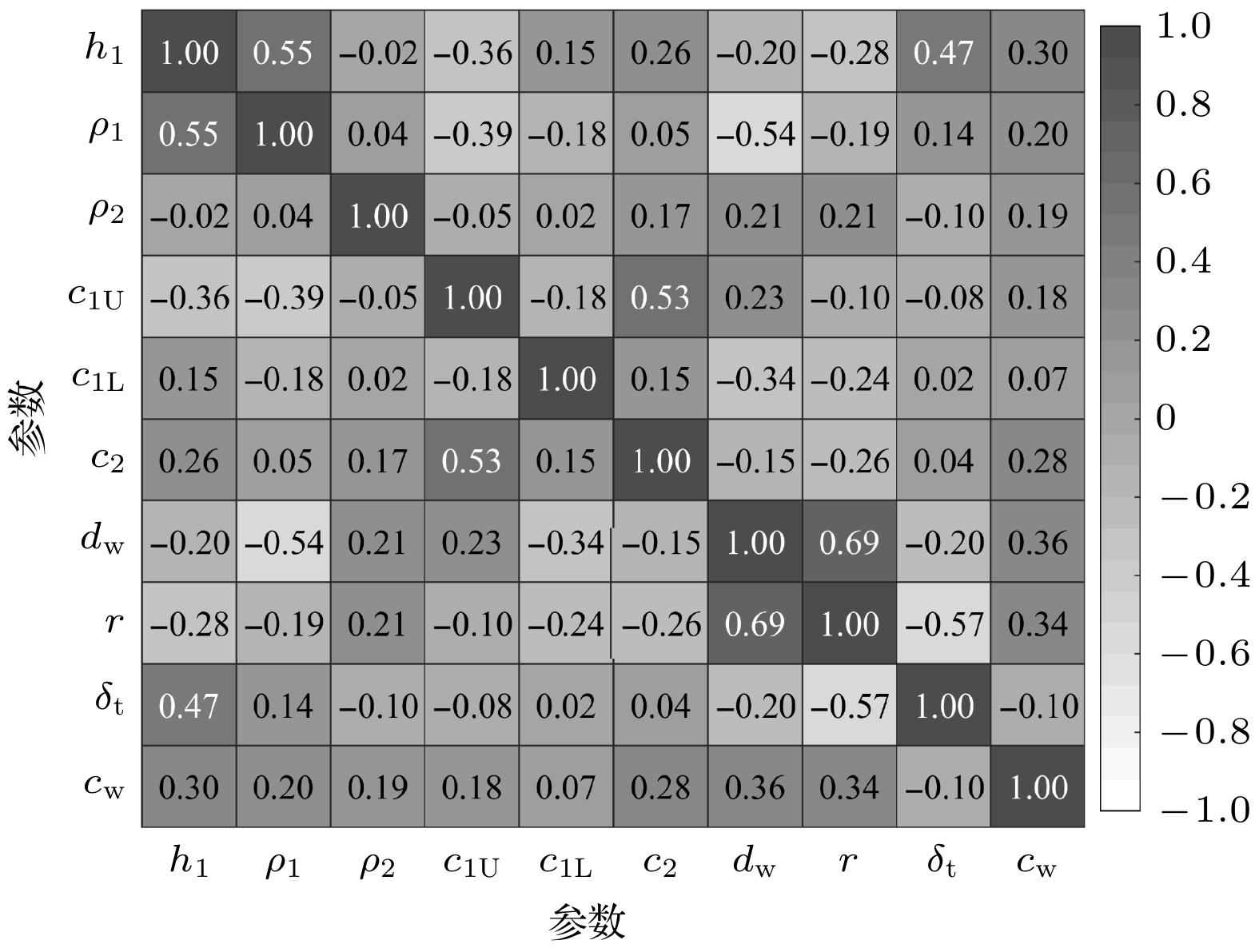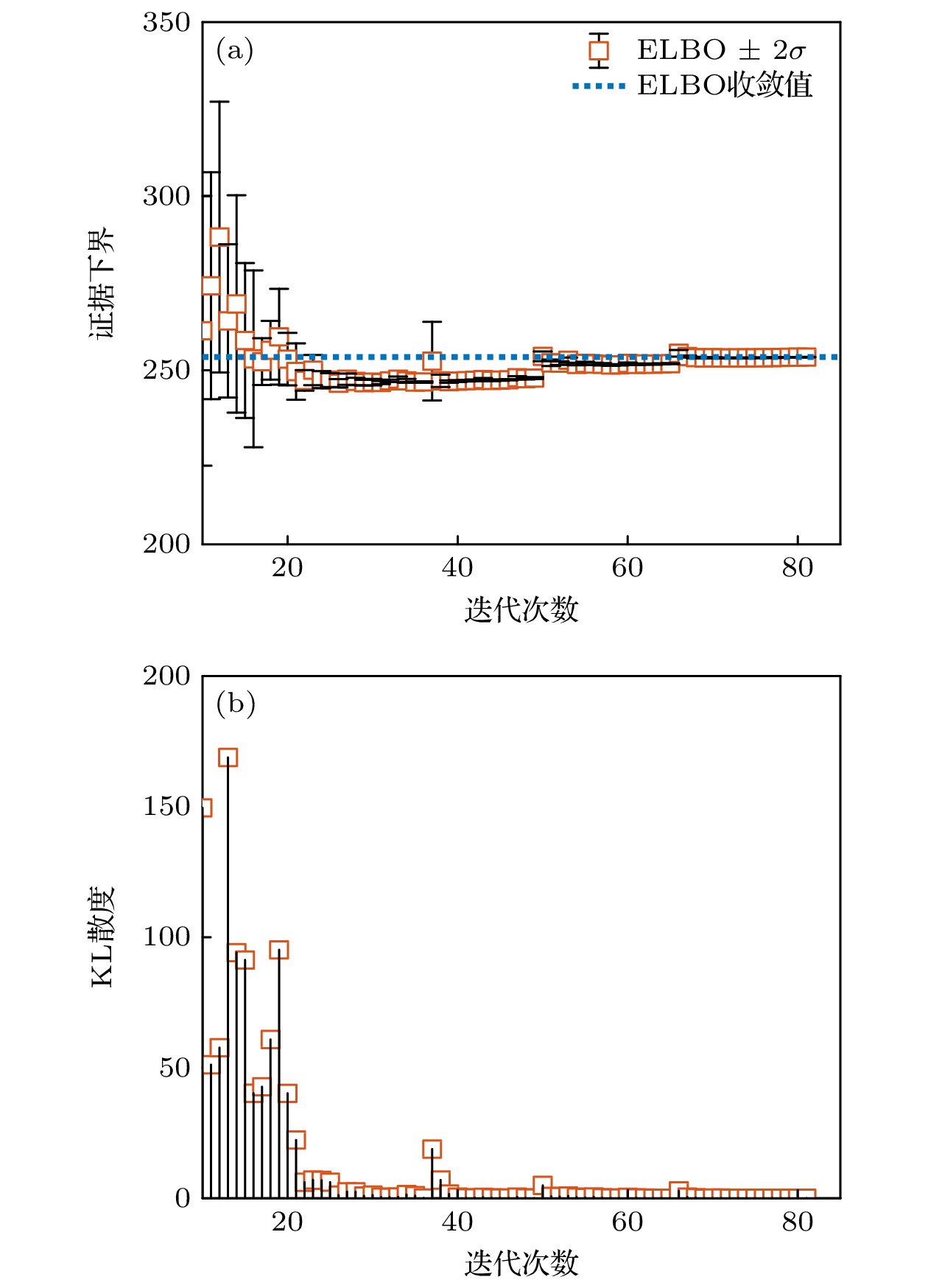-
大多数基于浅海简正波模态频散数据的地声参数反演方法无法对深层底质声学参数进行可靠估计, 究其原因是仅利用了简正波水波频散特征, 忽略了与深层底质声学参数密切相关的底波频散特征, 因此, 本文在分析了包含水波和底波的浅海宽带数据的基础上, 结合底波频散特征对深层底质声学参数变化更加敏感的物理特性, 实现了基于完整简正波频散特性的贝叶斯地声参数反演, 并针对简正波宽带声场模型计算复杂度较高的现实问题, 利用变分贝叶斯蒙特卡罗方法的推断优势, 完成了未知参数的可靠估计和快速后验分析. 仿真和海上实验结果表明: 联合简正波水波和底波频散特征数据的贝叶斯地声参数反演, 不仅可以有效估计深层底质声学参数, 而且降低了其他相关环境参数的估计不确定性.Most of shallow water geoacoustic inversions based on modal dispersion cannot reliably estimate the deep geoacoustic parameters. Because these studies focused on the dispersions of water waves but ignored the dispersions of ground waves. Therefore, in this paper a Bayesian geoacoustic inversion is studied based on wideband modal dispersions of water waves and ground waves. Firstly, the modal dispersion curves with Airy phase components are discussed. Secondly, the Bayesian inversion theory and a novel sample-efficient inference algorithm, namely Variational Bayesian Monte Carlo, are introduced briefly. In the Bayesian inversion, the posterior probability densities of unknown parameters are inferred, which can provide the prediction closest to the observation data and the uncertainty of the prediction. Considering that the forward acoustic model is computationally intensive, the posterior analysis is carried out by using the Variational Bayesian Monte Carlo method. It is performed by finding the variational distribution closest to the target distribution and requires less computation time than the Markov chain Monto Carlo method. In the simulation study, a range-independent two-layer seabed, including the sediment layer and basement layer, is modeled, on the assumption that the water column is homogeneous. The function of shear wave in waveguide is ignored. The compressional sound speed of the sediment layer varies linearly from c1U to c1L between 0 and h1, while other geoacoustic parameters are constant. By comparing the inversion results with and without the information of ground waves for different signal-to-noise ratios, it can be concluded that the deep geoacoustic parameters are more sensitive to the dispersions of ground waves. And then, a shallow-water experimental study is carried out in the Bohai Sea of China. The average water depth is about 20 m. The wideband pulse signals are recorded by a hydrophone with a sensitivity of –170 dB re 1 V/μPa. The received signals include well-defined Airy phase components, and the modal dispersion curves of water waves and ground waves are extracted accurately. The experimental results indicate that the Bayesian inversion combining water and ground wave dispersions can not only estimate the deep geoacoustic parameters reliably, but also reduce the inversion uncertainties of other model parameters, such as the shallow geoacoustic parameters, water depth, etc. The estimated source-receiver range and water sound speed are close to their measured values. The modal dispersion curves predicted by the posterior mean samples are in good consistence with those extracted from the experimental data in different ranges. In addition, the good forecast of transmission loss also demonstrates the reliability of the joint inversion.
-
Keywords:
- modal dispersion /
- geoacoustic inversion /
- water wave /
- ground wave
[1] 尚尔昌 2019 应用声学 38 468
 Google Scholar
Google Scholar
Shang E C 2019 Appl. Acoust. 38 468
 Google Scholar
Google Scholar
[2] Chapman N, Shang E C 2021 J. Theor. Comp. Acout. 29 2130004
 Google Scholar
Google Scholar
[3] Dosso S E, Dettmer J 2011 Inverse Probl. 27 055009
 Google Scholar
Google Scholar
[4] Shen Y, Pan X, Zheng Z, Gerstoft P 2020 J. Acoust. Soc. Am. 148 3279
 Google Scholar
Google Scholar
[5] 杨坤德, 马远良 2009 物理学报 58 1798
 Google Scholar
Google Scholar
Yang K D, Ma Y L 2009 Acta Phys. Sin. 58 1798
 Google Scholar
Google Scholar
[6] Chapman N 2016 J. Mar. Sci. Eng. 4 61
 Google Scholar
Google Scholar
[7] Bonnel J, Chapman N 2011 J. Acoust. Soc. Am. 130 EL101
 Google Scholar
Google Scholar
[8] 郭晓乐, 杨坤德, 马远良 2015 物理学报 64 174302
 Google Scholar
Google Scholar
Guo X L, Yang K D, Ma Y L 2015 Acta Phys. Sin. 64 174302
 Google Scholar
Google Scholar
[9] Duan R, Chapman N, Yang K D, Ma Y L 2016 J. Acoust. Soc. Am. 139 70
 Google Scholar
Google Scholar
[10] 李佳蔚, 鹿力成, 郭圣明, 马力 2017 物理学报 66 204301
 Google Scholar
Google Scholar
Li J W, Lu L C, Guo S M, Ma L 2017 Acta Phys. Sin. 66 204301
 Google Scholar
Google Scholar
[11] Lin Y T, Lynch J F, Chotiros N, Chen C F, Newhall A, Turgut A, Schock S G, Chiu C S, Bartek L, Liu C S 2004 IEEE J. Oceanic Engineer. 29 1231
 Google Scholar
Google Scholar
[12] Wan L, Badiey M, Knobles D P, Wilson P S 2018 J. Acoust. Soc. Am. 143 EL199
 Google Scholar
Google Scholar
[13] Blei D M, Kucukelbir A, McAuliffe J D 2017 J. Am. Stat. Assoc. 112 859
 Google Scholar
Google Scholar
[14] Acerbi L 2018 arXiv: 1810.05558 v2 [stat. ML]
[15] Che Y F, Wu X, Pastore G, Li W, Shirvan K 2021 Ann. Nucl. Energy 153 108046
 Google Scholar
Google Scholar
[16] Jensen F B, Kuperman W A, Porter M B, Schmidt H 2011 Computational Ocean Acoustics (Vol. 2) (New York: Springer) pp337–452
[17] Dosso S E, Nielsen P L, Wilmut M J 2006 J. Acoust. Soc. Am. 119 208
 Google Scholar
Google Scholar
[18] Porter M B 1991 The KRAKEN Normal Mode Program (La Spezia: SACLANT Undersea Research Center) Technical Report SM-245
[19] Bonnel J, Thode A, Wright D, Chapman N 2020 J. Acoust. Soc. Am. 147 1897
 Google Scholar
Google Scholar
[20] Daubechies I, Lu J F, Wu H T 2011 Appl. Comput. Harmon. A. 30 243
 Google Scholar
Google Scholar
[21] Dosso S E, Wilmut M J, Lapinski A L S 2001 IEEE J. Oceanic Engineer. 26 324
 Google Scholar
Google Scholar
[22] 王鹏, 贾凯, 吴建政, 胡日军 2015 海洋地质与第四纪地质 35 23
Wang P, Jia K, Wu J Z, Hu R J 2015 Marine Geology Quaternary Geology 35 23
[23] 张剑, 李日辉, 王中波, 张训华, 黄龙, 孙荣涛 2016 海洋地质与第四纪地质 36 1
Zhang J, Li R H, Wang Z B, Zhang X H, Huang L, Sun R T 2016 Marine Geology & Quaternary Geology 36 1
[24] Li Z L, Zhang R H 2004 Chin. Phys. Lett. 21 1100
 Google Scholar
Google Scholar
-
图 3 1阶模态群速度曲线 (a)不同的
$ {h_1} $ ; (b)不同的${c_{{\text{1 L}}}}$ ; (c)不同的${c_2}$ ; (d)不同的${\rho _2}$ , 圆圈给出了艾里相频率的位置Fig. 3. Group velocity curves of Mode 1: (a) Different values of
$ {h_1} $ ; (b) different values of${c_{{\text{1 L}}}}$ ; (c) different values of${c_2}$ ; (d) different values of${\rho _2}$ . The circles indicate the Airy phase frequencies.表 1 VBMC算法步骤
Table 1. Steps of the VBMC algorithm.
算法 : 变分贝叶斯蒙特卡罗(Acerbi, 2018) 1: $t \leftarrow 0$, 初始化GMM模型参数${\phi _0}$和${K_0}$ 2: When 收敛条件未满足, do 3: $t \leftarrow t + 1$ //迭代 4: for $ 1 \ldots {n_{\text{active}} }$ do 5: 采样新的样本点$\boldsymbol{\theta} _{\rm new} \leftarrow {\rm argmax}_{\boldsymbol{\theta}} [a({\boldsymbol\theta})]$ //$a({\boldsymbol{\theta }})$
为采样函数6: 计算样本点的$ \log p(\boldsymbol{d}, {\boldsymbol{\theta} _{\text{new}} }) $值, 并将其加入训练集 7: $\log p({\boldsymbol{d}}, {\boldsymbol{\theta}} ) \leftarrow$训练GP模型, 得到最优的模型超参数 8: ${K_t} \leftarrow $更新GMM模型参数 9: ${\phi _t} \leftarrow $利用随机梯度下降法对ELBO寻优, 更新GMM
模型参数10: end 表 2 反演参数空间和先验区间
Table 2. Parameter spaces and prior bounds for inversion.
待反演参数 单位 仿真参数值 先验区间 沉积层厚度$ {h_1} $ m 47 [10, 80] 沉积层密度${\rho _1}$ ${\text{g/c}}{{\text{m}}^{\text{3}}}$ 1.5 [1, 2] 基底层密度${\rho _2}$ ${\text{g/c}}{{\text{m}}^{\text{3}}}$ 2.1 [1.5, 2.5] 沉积层上部声速$ {c_{1{\text{U}}}} $ ${\text{m/s}}$ 1675 [1600, 1700] 沉积层下部声速$ {c_{1{\text{L}}}} $ ${\text{m/s}}$ 1675 [1650, 1750] 基底层声速$ {c_2} $ ${\text{m/s}}$ 1765 [1700, 1800] 水深dw m 21 [15, 25] 收发距离$r$ km 6.24 [4, 8] 时间因子$ {\delta _{\text{t} }} $ s — [–0.5, 0.5] 水体声速cw ${\text{m/s}}$ 1511 [1500, 1520] 表 3 针对数据条件1的后验统计结果
Table 3. Posterior statistical results for Data 1.
待反演参数 均值 方差 95%可信区间 实测值 $ {h_1} $ 46.65 3.77 [39.69, 54.21] — ${\rho _1}$ 1.52 0.09 [1.35, 1.69] — ${\rho _2}$ 2.12 0.19 [1.75, 2.44] — $ {c_{1{\text{U}}}} $ 1675.89 9.40 [1654.35, 1690.32] — $ {c_{1{\text{L}}}} $ 1673.52 8.04 [1660.41, 1691.35] — $ {c_2} $ 1765.03 15.78 [1731.16, 1789.77] — $ {d_{\text{w}}} $ 20.69 0.45 [19.70, 21.41] 19—22 $r$ 6.24 0.30 [5.63, 6.83] 6.07 $ {\delta _{\text{t}}} $ 0.280 0.002 [0.276, 0.284] — $ {c_{\text{w}}} $ 1510.98 4.13 [1503.08, 1517.91] 1511—1513 -
[1] 尚尔昌 2019 应用声学 38 468
 Google Scholar
Google Scholar
Shang E C 2019 Appl. Acoust. 38 468
 Google Scholar
Google Scholar
[2] Chapman N, Shang E C 2021 J. Theor. Comp. Acout. 29 2130004
 Google Scholar
Google Scholar
[3] Dosso S E, Dettmer J 2011 Inverse Probl. 27 055009
 Google Scholar
Google Scholar
[4] Shen Y, Pan X, Zheng Z, Gerstoft P 2020 J. Acoust. Soc. Am. 148 3279
 Google Scholar
Google Scholar
[5] 杨坤德, 马远良 2009 物理学报 58 1798
 Google Scholar
Google Scholar
Yang K D, Ma Y L 2009 Acta Phys. Sin. 58 1798
 Google Scholar
Google Scholar
[6] Chapman N 2016 J. Mar. Sci. Eng. 4 61
 Google Scholar
Google Scholar
[7] Bonnel J, Chapman N 2011 J. Acoust. Soc. Am. 130 EL101
 Google Scholar
Google Scholar
[8] 郭晓乐, 杨坤德, 马远良 2015 物理学报 64 174302
 Google Scholar
Google Scholar
Guo X L, Yang K D, Ma Y L 2015 Acta Phys. Sin. 64 174302
 Google Scholar
Google Scholar
[9] Duan R, Chapman N, Yang K D, Ma Y L 2016 J. Acoust. Soc. Am. 139 70
 Google Scholar
Google Scholar
[10] 李佳蔚, 鹿力成, 郭圣明, 马力 2017 物理学报 66 204301
 Google Scholar
Google Scholar
Li J W, Lu L C, Guo S M, Ma L 2017 Acta Phys. Sin. 66 204301
 Google Scholar
Google Scholar
[11] Lin Y T, Lynch J F, Chotiros N, Chen C F, Newhall A, Turgut A, Schock S G, Chiu C S, Bartek L, Liu C S 2004 IEEE J. Oceanic Engineer. 29 1231
 Google Scholar
Google Scholar
[12] Wan L, Badiey M, Knobles D P, Wilson P S 2018 J. Acoust. Soc. Am. 143 EL199
 Google Scholar
Google Scholar
[13] Blei D M, Kucukelbir A, McAuliffe J D 2017 J. Am. Stat. Assoc. 112 859
 Google Scholar
Google Scholar
[14] Acerbi L 2018 arXiv: 1810.05558 v2 [stat. ML]
[15] Che Y F, Wu X, Pastore G, Li W, Shirvan K 2021 Ann. Nucl. Energy 153 108046
 Google Scholar
Google Scholar
[16] Jensen F B, Kuperman W A, Porter M B, Schmidt H 2011 Computational Ocean Acoustics (Vol. 2) (New York: Springer) pp337–452
[17] Dosso S E, Nielsen P L, Wilmut M J 2006 J. Acoust. Soc. Am. 119 208
 Google Scholar
Google Scholar
[18] Porter M B 1991 The KRAKEN Normal Mode Program (La Spezia: SACLANT Undersea Research Center) Technical Report SM-245
[19] Bonnel J, Thode A, Wright D, Chapman N 2020 J. Acoust. Soc. Am. 147 1897
 Google Scholar
Google Scholar
[20] Daubechies I, Lu J F, Wu H T 2011 Appl. Comput. Harmon. A. 30 243
 Google Scholar
Google Scholar
[21] Dosso S E, Wilmut M J, Lapinski A L S 2001 IEEE J. Oceanic Engineer. 26 324
 Google Scholar
Google Scholar
[22] 王鹏, 贾凯, 吴建政, 胡日军 2015 海洋地质与第四纪地质 35 23
Wang P, Jia K, Wu J Z, Hu R J 2015 Marine Geology Quaternary Geology 35 23
[23] 张剑, 李日辉, 王中波, 张训华, 黄龙, 孙荣涛 2016 海洋地质与第四纪地质 36 1
Zhang J, Li R H, Wang Z B, Zhang X H, Huang L, Sun R T 2016 Marine Geology & Quaternary Geology 36 1
[24] Li Z L, Zhang R H 2004 Chin. Phys. Lett. 21 1100
 Google Scholar
Google Scholar
计量
- 文章访问数: 7118
- PDF下载量: 98
- 被引次数: 0














 下载:
下载:

